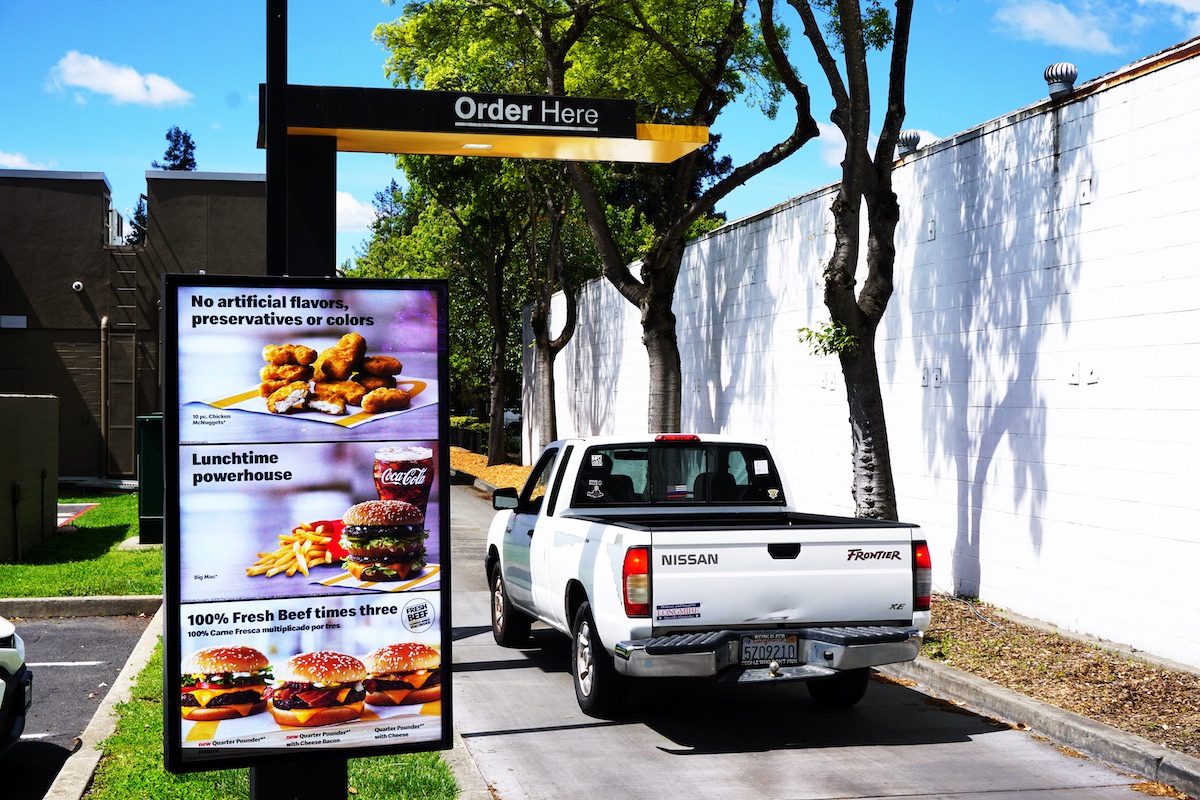
How Outdoor Screens Can Win The Ongoing Fight With The Sun
April 9, 2021 by Dave Haynes
Guest Post: Mark Madigan, MAC Thin Films

Putting big LCD screens outside, in direct sunlight, presents a major technical design challenge, but probably not the challenge you have in mind.
Making screens bright enough to be viewable in the glare of the sun has long since been sorted out. The real challenge, still, is keeping those bright screens working despite the relentless daily heat load of the sun.
There are a couple of main factors in play:
- A high-brightness LCD pushing 2,500 nits or more of brightness generates a lot of heat from all those little LED backlights;
- That’s compounded by the add-on heat load from direct sunlight. While the problem may be more acute in Phoenix in July, put your hand on the hood of a car on a hot August day in Bangor, Maine and you’ll understand how heat build-up is not limited to the hottest regions of a country.
Direct sunlight’s heat makes it necessary to actively cool outdoor displays to prevent the internal temperature from rapidly rising in a display enclosure, and taking on the debilitating properties of an oven.
Preventative measures
Display manufacturers have focused on using fans, heat exchangers and venting systems to get the heat out and prevent damage, which can include visible flaws like black isotropic blotches on the LCD layer. Punishing heat loads can also shorten the operating lives and elevate operating costs, directly impacting the total cost of ownership.
Fans are often used to draw out the heat, but steadily-spinning fans add to energy consumption costs, require maintenance, and represent a moving part. Any person experienced with technology hardware will tell you: “Moving parts break.”
Breaks mean service disruptions. Unplanned repair costs. And unhappy clients or bosses.
If there is a Holy Grail quest in the outdoor digital display business, it’s finding some sort of coating that rejects much of the sun’s infrared light, reducing the heat load and energy consumption and extending operating lifespans.
There are films and coatings on the market, but most come with limitations. IR rejection films, for example, can shrink, expand and shift as the sun beats down it, affecting the visuals.
Heat gets transferred from hotter objects to cooler objects in one of three ways: conduction, convection, and radiation.
An outdoor display system is affected by all three. Conductive heat transfer happens with the various materials that make up an outdoor display, while convective heat transfer occurs with the wind. Radiative heat transfer, meanwhile, comes from direct sunlight.
A coated solution
Outdoor displays have cover glass that protects the LCD layer against environmental conditions and abuse. The ideal cover glass solution for an outdoor display, especially those used in warm climates, will have two key characteristics:
- Significant rejection of near-infrared (NIR) solar energy to prevent heat buildup and decrease cooling demands;
- A high emissivity, which allows the transfer of thermal energy from the display to its surroundings.
The company I run, MAC Thin Films, does precision coatings for applications like displays that need anti-reflective properties. Our products help industries supply use-cases like digital signage and digital OOH, but we also supply solutions for mission-critical jobs like commercial aircraft cockpits.
The best way to test and assess what happens with displays when they’re out in the sun is to wheel a test unit outside on a sunny day, eyeball the viewability and take temperature readings. We went well past that, doing thermal analysis modeling with the help of the Lawrence Berkeley National Laboratory (LBNL) and its simulation software.
You’d need a specialized education or experience to understand the findings, so suffice to say we’ve developed, tested and now validated an infrared blocker coating that makes a genuine difference in rejecting the heat of the sun.
We confirmed that by using a coated cover glass that blocks IR. In testing, 32% of invisible solar thermal radiation was reflected, compared to just 7% for a display using uncoated cover glass. While the coating reduces the amount of heat getting in, it has no effect on the “emissivity” of the cover glass, allowing heat building up inside to flow outward.
In short, it stops a lot of the sun’s heat from getting in, but also lets escape the heat that builds up inside from the LED backlights. It also has no negative effect on the viewability of the screens, counteracting glare and reflection.
Bottom line benefits
Effective heat handling has a direct bottom line effect on outdoor-rated displays. The need for active cooling is reduced, which can lower manufacturing costs (through elimination or lowered-demand, lower-cost components).
A significant energy savings for the display owner can also be realized through the reduction of ongoing cooling costs that are associated with display operation. For example, an annual savings of $30 for a 55-inch display is a reasonable expectation in Los Angeles. That may not seem like much money, but costs add up when there are hundreds or even thousands of units.
The energy savings also benefit the environment through a reduction in energy consumption.
Another tangible benefit is that the units will last significantly longer, because of the reduced heat load and cooling demands.
Ideally, outdoor displays have the engineering design that keeps them running, but has no adverse impact on visuals. Done right, heat load is reduced, energy costs drop and consumers clearly see bright, crisp messaging, in any kind of environmental conditions.
ABOUT THE WRITER
Mark Madigan is a seasoned optical industry executive with deep experience in the thin film manufacturing industry. He led executive management and business development teams at JDSU, Sonoma Photonics and OCLI (Optical Coating Laboratory, Inc.) before founding MAC Thin Films in 2014. Mark’s goal for MAC Thin Films is to build upon a successful long-term track record of collaborative innovation with key customers to deliver solutions with differentiated value to customers around the world.



Leave a comment